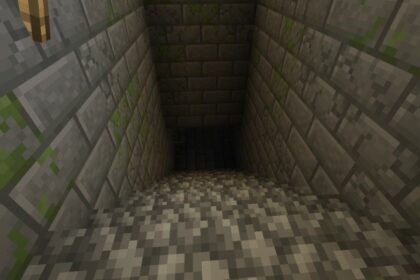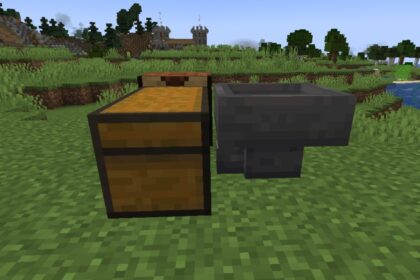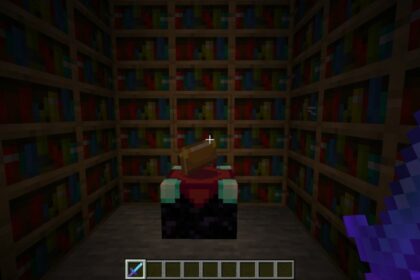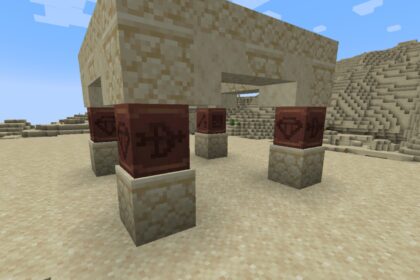As useful as water is in Minecraft, sometimes it can get in the way.
Whether its a bunch of flowing water making it hard to get up a mountain or out of a cave, or deep water that makes it hard to get to something, it’s useful knowing how to get rid of water in Minecraft.
There’s many ways to remove water in Minecraft, depending on the situation you’re in. I will go over some of the most common ways for how to get rid of water in this article.
How Does Water Work in Minecraft?
If you’ve ever found a waterfall in Minecraft, you could have observed that they always come from a single hole in the wall.
Moving water always comes from at least one source block. A source block is a block of water (or lava) that rests horizontally on a surface. This source block appears as still water and from it water can flow.

In order to remove a waterfall you have to either obstruct or remove the source block, and the entirety of the waterfall is then removed.
In the case of lakes, rivers, and other larger bodies of water, that is a little more difficult. These bodies of water are made of source blocks that infinitely flow into one another, creating an infinite water source.
This means that if you remove a single block of water using a bucket, the water will just flow right back in place. This is when getting rid of water becomes tricky and I’m here to help.
How to Get Rid of Water From a Single Source Block
Usually a single source block of water is not a problem if it’s located in a hole in the dirt. Those can easily be picked up by a bucket or covered by a solid block to be removed.
The problem with single source blocks comes when this block is inside a cave or inside a wall. You can often come across the problem of flowing water making it difficult to exit or enter parts of caves.

Not to mention, as long as water has enough space to flow it can flow infinitely.
If it’s early in the game and you don’t have a bucket, getting rid of a single source block of water is still easy. You can either place any block directly on the source block, which would completely get rid of it, or you can place a block in front of its hole.

Sometimes having flowing water will come in handy, so getting completely rid of water could hinder you later on.
Remember that waterfalls can be used as a cheap alternative to getting in and out of caves, just like Vines you can grow in Minecraft, in case you don’t have Ladders or Scaffolding.
In other cases, flowing water can keep Mobs like Creepers and Zombies from going after you in a cave. It can make it easier to kill the Mobs.
I’d suggest making a bucket and collecting the water that way, rather than fully destroying the source block. That way the Water is not in your way, but you can still utilize it when needed, against mobs, lava, or to reach deeper parts of caves.

How to Get Rid of Multiple Sources of Water
Larger of bodies can hide all kinds of goods. From sunken ships that lead to buried treasure in ocean biomes, to ores and passages inside caves.
Deep water can also be a good place to build a secret futuristic base, but to achieve this you need to somehow get rid of that water.
Filling the area
One way I’ve gone about this in the past has been using either sand, gravel or dirt.
Placing them in the water in great numbers destroys the source blocks, disabling the water from filling them in once the blocks are broken.
However, this takes quite a bit of time to do, and you’re surely to go through several shovels in the process. Not to mention, it can be a bit tricky too, depending on the size and depth of the water you’re removing.
To do this try blocking out an area, preferably with Gravel or Sand as these drop to the bottom due to gravity.

Once you have your area blocked out, you can fill it in with gravel or sand and when all the water is gone, you can mine the blocks back out. This leaves a big empty area for you to use.


Using Sponges
The most efficient was of removing water is using sponges.
Sponges are blocks that can be found only inside of ocean monuments, making them a very valuable resource.
In ocean monuments sponges can be found in sponge rooms which are usually empty of water and contain wet Sponges along the ceiling and walls. They can be mined with any tool, but a regular hoe will break them the fastest.
Now, a wet sponge cannot be used to collect any more water. Consider a wet sponge to be a sponge at full capacity.
In order to get a dry sponge you will need to, actually dry the already wet sponge. To dry a wet sponge you will have to put them in a furnace with a flammable item, like you were trying to cook it.
This will give you back a dry sponge.
Then, when a dry sponge is placed back in water it’ll absorb anywhere between 3 to 5 blocks of water around it. It will then become a wet sponge again.

This way you can clear out much larger areas and within a smaller timespan, without wasting tools your either.
Do keep in mind that going into an ocean monument to get sponges can be dangerous. So when you do find one, remember to be well prepared.






